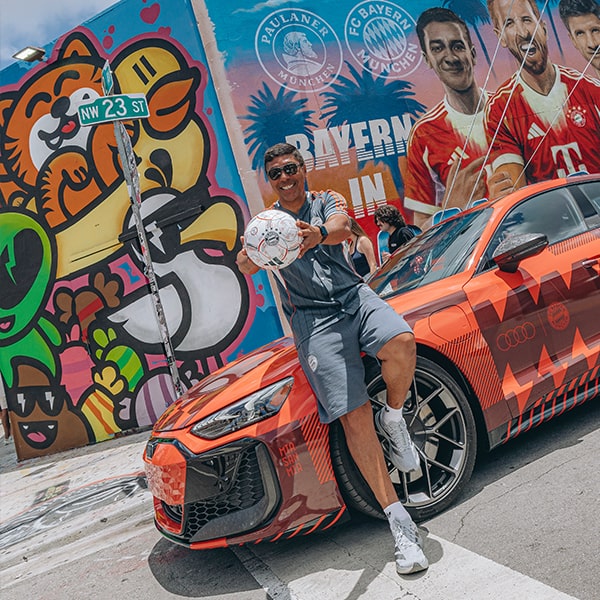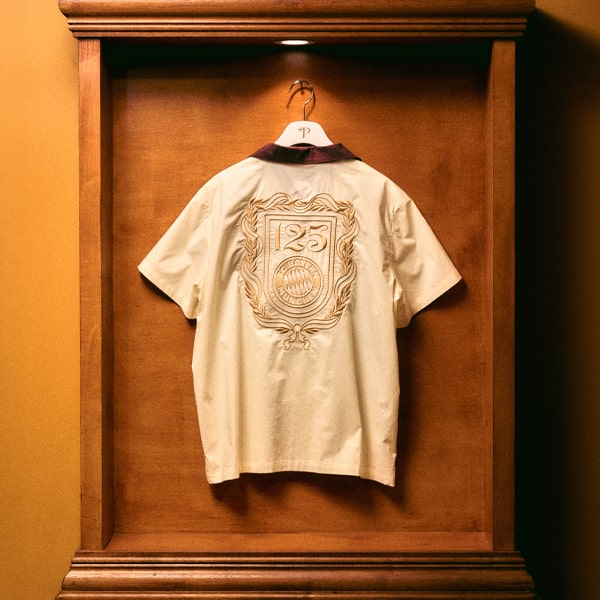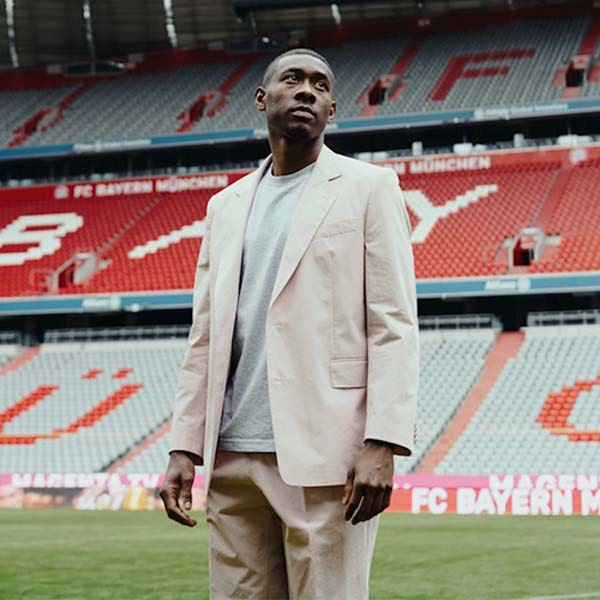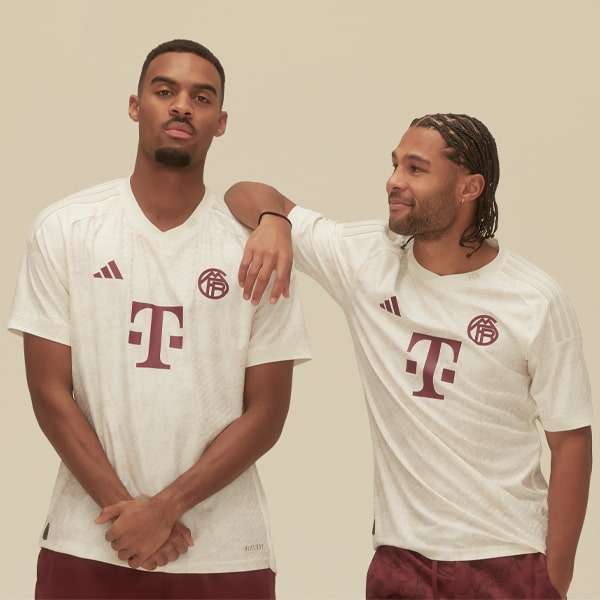In a city where football is becoming a cultural force, Miami-based photographer Daniel Zuliani is capturing the movement from the inside out. Here, he speaks on creativity, culture, and what it means to shoot with purpose.
As part of the Club World Cup celebrations, the streets of Miami were recently transformed into a runway for creativity, with FC Bayern, Audi, and club legend Elber at the wheel. Enter Daniel Zuliani—a photographer whose lens lives where sport, street, and soul collide. We linked up with Zuliani to capture a moment that was anything but ordinary: the Audi RS e-tron GT Performance in full Bayern regalia, carving through Miami’s layers of culture and chaos.
With the pulse of Brazil in his blood and Miami’s energy underfoot, Zuliani brings a raw honesty to his work. His style? Grit over gloss, emotion over edits. We sat down with him to unpack how football fuels the city’s creative identity—and why this shoot was more than just visuals. This was storytelling. A tribute to movement, memory, and the ever-blurring lines between the pitch and the pavement.
How would you describe your style as a photographer? What draws you to the moments you choose to capture?
I’ve always enjoyed photography in all its forms—fashion, music, travel, lifestyle, sports—you name it. I’ve shot a lot of different things, and through that I’ve learned a lot about my style, my gear, and how I like to edit. I gravitate toward real, live moments—people doing what they do best in the most natural way. That’s why I love shooting music and sports so much. There's a rawness and emotion that translates well in-camera. At the same time, I really enjoy structured campaigns too—especially when we get time to develop a concept and execute it at a high level. I take a lot of pride in my editing process. I want each image to reflect what I felt when I captured it.
What does a day behind the lens in Miami look like for you?
It really depends. Some days start at 5 a.m. with a sunrise shoot and end at 1 a.m. after a campaign wraps. Other days are slow—maybe a gym session, a walk with my dog, then a chill shoot in the afternoon. Sometimes I don’t even leave the house until night, just to shoot a show or a game. Being from Brazil, living in Miami feels like the closest I can get to home while still being in the U.S. I got here early, as the creative scene was starting to build, and I’ve been lucky to grow alongside it. The city has its own rhythm, and I feel blessed to be part of it.
Do you remember the first time you felt a connection between football and creativity?
I’ve loved football my whole life. I’d watch a fourth division game if it was on. But the creative connection came a few years ago, when I shot my first match—Brazil vs. Colombia in Miami. I entered through the same tunnel the players used. The energy was surreal. I grew up watching those players, and suddenly I was right next to them. From that moment on, I started shooting matches as a fan first. I want my photos to feel like something a supporter would want to see. That’s my lens—emotion, energy, and authenticity.
In a fast, loud city like Miami, what inspires you to pause and shoot?
Travel, honestly. Stepping away from the city gives me fresh eyes when I come back. Miami can become routine if you’re here all the time. But when I return, I realize how many people would love to be in my shoes—working in this space, in this city. That refreshes me. For this project specifically, we hit familiar locations, but the goal was to shoot them in a new light. Find new angles, new textures. It’s about giving people a different view of a city they think they already know.
What’s your approach when documenting culture—do you plan it or let the city guide you?
A bit of both. In big cities like Miami, it’s easy to fall into clichés. So I tend to shoot spaces I actually enjoy—places I go to, spots I connect with. If I’m documenting a coffee shop, I’ll pick the one I’ve been vibing with lately, not the one everyone else is posting. That helps me keep the work honest. I want to show the city through my lens, not just replicate what’s already out there.
Football isn’t just a sport here—it’s a lifestyle. How do you see it influencing Miami’s creative identity?
It brings global eyes to the city. Messi, Beckham, big names—they all help elevate the game, but they also bring creatives from around the world to experience Miami through football. The Club World Cup is a great example. You had teams from Germany, Argentina, Brazil—all with their own creative crews documenting their journeys. That mix brings fresh energy, and the city becomes a canvas for global football culture. It inspires those of us already here and offers outsiders a different view of Miami beyond the postcards.
What happens when football collides with art, design, and street culture?
There’s a fine line—it can either feel forced or absolutely beautiful. But when done right, it tells powerful stories. Look at some of the kits designed for the Club World Cup—like Palmeiras or Inter Miami. They’re stunning. These designs aren’t just jerseys; they’re statements that blend heritage with modern culture. Football is having its fashion moment—pregame fits, collabs, limited editions. It’s all crossing over. People are wearing these shirts without even knowing the teams behind them. And that’s when culture wins.
What does a club like Bayern Munich represent to you, creatively?
When I think of Bayern, I think of sleek design, modern lines—very German. So bringing that into Miami, a city that’s colorful, loose, and Latin, was an interesting challenge. But it worked. We found a balance. That contrast—modern vs. vintage, serious vs. playful—it created a dynamic tension that made the project feel rich. The red of the car popped against the blue skies and green landscapes. It was elegant and expressive at once.
Do you see photography as a way to make people feel football more personally?
Absolutely. That’s how I approach every game. I want to capture it like a fan, not just document it. The emotion in the stands, the tension on the pitch, the tiny details people miss—it all tells a story. Football is layered. It’s not just 90 minutes—it’s the rain, the confetti, the coach yelling, the ultras drumming. Photography lets you freeze all of that. And when you do it right, people feel it deeply.
Why do you think Miami has become such a powerful hub for football culture?
It’s the people. Miami is full of Latin communities—Brazilians, Argentinians, Colombians, Venezuelans. For us, football is everything. We just needed a team to rally around. Now that Inter Miami is on the rise, and with global moments like the Club World Cup and the upcoming World Cup, the city finally has the stage it deserves. The passion was always here. Now it has somewhere to go.
From rooftops to matchdays—how do you see the game expressed outside the stadium?
The jerseys are everywhere. The pop-up events, the street culture—it’s alive. I remember pulling up to the vintage jersey drop in Wynwood for the Bayern event and being blown away by the line around the block. People are showing up. They’re hungry for more moments like that. Whether it's an Arsenal bar or a beach activation, the fans are here. The more we give them, the more the culture will grow.
What’s the most “Miami” moment you’ve had shooting something football-related?
Shooting in the middle of the Inter Miami supporters' section. It was loud, passionate, fully in Spanish—drums, smoke, confetti flying. It didn’t feel like the U.S., and that’s what made it so beautiful. These fans are fully committed. Some don’t even watch the game—they’re just there to create an atmosphere. It’s wild. It’s love.
What did driving the Bayern-wrapped Audi around Miami unlock for you creatively?
It was about contrast. You’ve got a sleek, red sports car—clean German design—against the vibrant chaos of Miami. It made me think about alignment. How do I tell a story that makes these worlds blend? The textures, the lighting, the reactions we got on the street—all of it fed into that idea of football meeting art, design, and place. And to shoot it with friends, for a brand I respect, made it that much more special.
What role do brands like Audi play in pushing football beyond the pitch?
A huge one. They gave us room to do our thing. They didn’t just say “show the logo.” They understood the culture—how it lives, breathes, and looks different in every city. For them to trust local creatives, to invest in storytelling, and to lean into the experience... that’s how football grows. They’re not just in the game—they’re part of the culture around it. That makes all the difference.
If this project says one thing about the future of football and culture, what should it be?
That football is just getting started in the U.S. It’s already massive globally, but here? We’re building something. From Club World Cup to Copa América, to the World Cup in 2026—this is the beginning. Football touches everything: fashion, design, community, identity. And the fact that you can watch it almost every day, from so many places, with so many styles—it just keeps evolving. That’s what makes it beautiful. It’s global, it’s personal, and it’s here to stay.
Shop the Bayern Munich 25/26 kit at prodirectsport.com/soccer






























